The True Cost of Living on a Sailboat: Our Monthly Expenses
As an Amazon Associate, we earn from qualifying purchases. We also earn from other affiliate websites. See our full disclaimer.
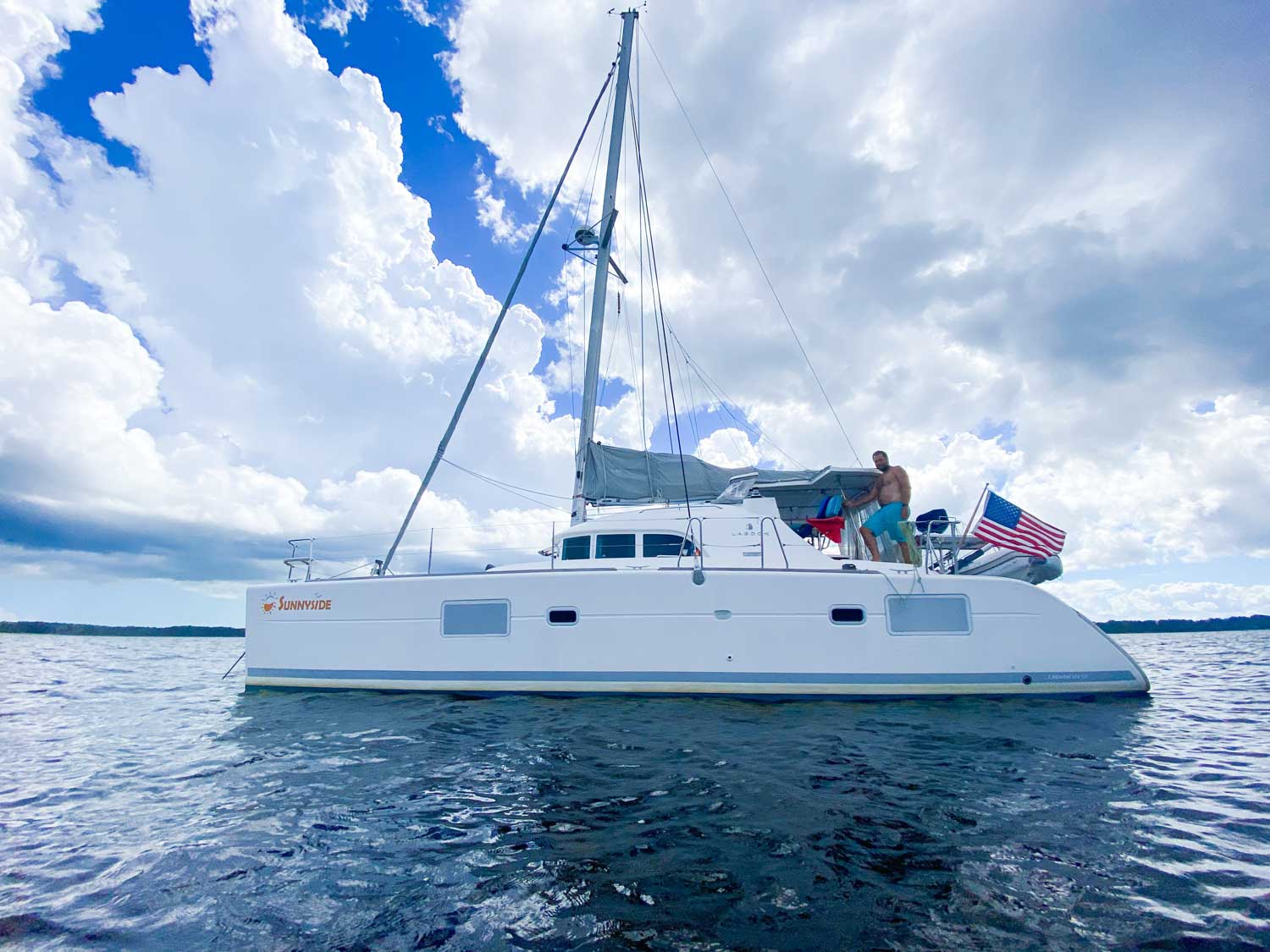
How much does it cost to live on a boat? This was my biggest question when we were planning and saving to cruise. I was clueless when it came to creating a budget for our future life aboard. I was looking for someone to tell me exactly how much it would cost ME to live on a sailboat full-time.
I quickly learned some people cruise for less than $1,000 a month and some for upwards of $10,000 a month. Most are somewhere between.
Not so dissimilar from living on land, different people cruise on all sorts of budgets.
For us, our cost of living on a sailboat isn’t so far from our land-based spending.
Part of this journey was learning to live with less, but we still maintain some creature comforts on the water.
Here is a breakdown of our cost of living on a boat full-time while cruising the US east coast.
Cost to Live on a Sailboat
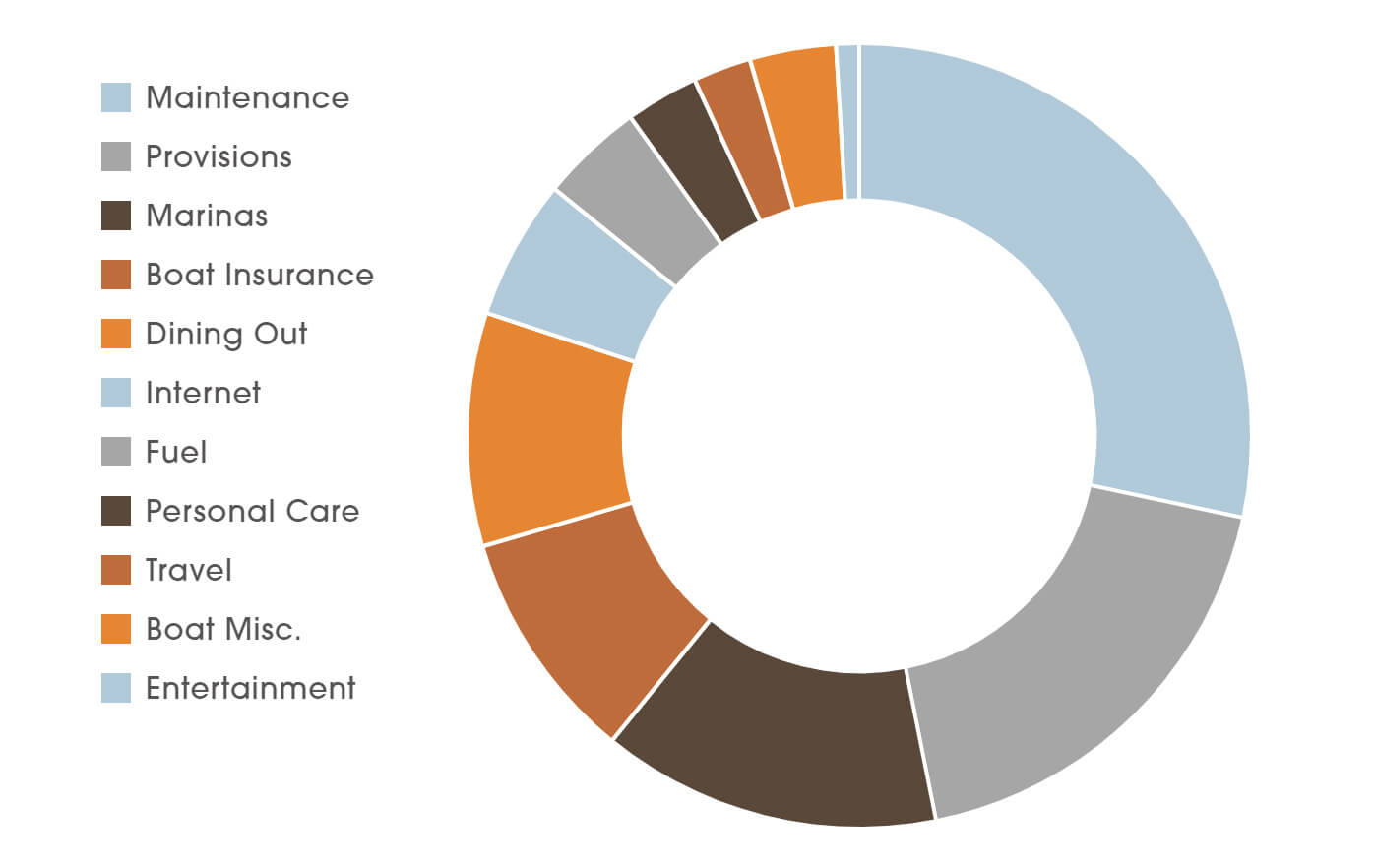
Average cost of $2,424 per month*
Sailboat Maintenance Expenses
Average Cost $1,006
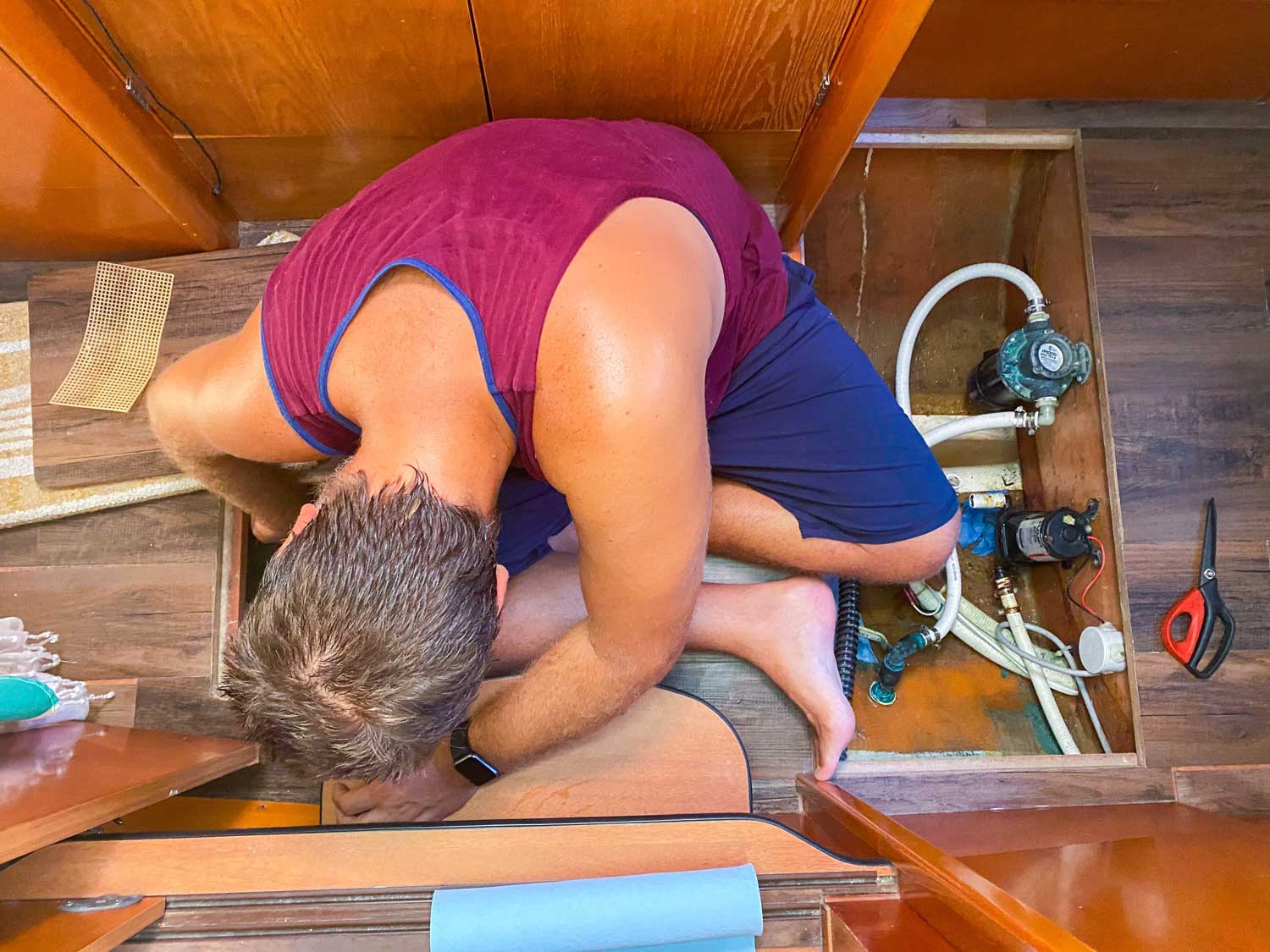
Maintenance, Parts & Tools ($687)
It’s no surprise boat maintenance is top of the list.
You will continuously be fixing broken things or maintaining things on a sailboat. You will also need different tools, spare parts, cleaners, etc., as you cruise.
There will be months when you won’t need much in the way of tools and parts (especially if you already have a lot of tools and spare parts onboard). Then in one month, you might spend 40% of the annual budget.
We make a strong effort to do most boat projects ourselves.
Shortly after we began cruising, our wallets learned the hard truth of paying people to work on your boat.
Since then, we’ve been our own plumber, mechanic, seamstress, and electrician.
You’ll always be learning. But if you can maintain and fix your vessel, you’ll save boatloads of cash (pun intended, I couldn’t resist).
READ NEXT: Check out our 9 Helpful Things You Need in Your Sailboat Tool Kit.
Insurance ($233)
If you are a newbie cruiser, your boat insurance options will most likely be limited. Insurance was a considerable expense in our first year. In our second year, the cost dropped from 2.8% of the boat’s value to 1.3%. (We now have restricted cruising grounds for July – November.)
Do your research and consider using a broker. Get quotes based on where you’ll be cruising and staying in hurricane season.
Miscellaneous ($86)
The miscellaneous category is everything else boat-related. This includes any small purchases we make for the boat (ex. rug for the salon), our USCG documentation, Amazon Prime membership, etc.
We also have a Boat US membership, which more than pays for itself. We get dockage and fuel discounts often. And, of course, the towing service is priceless when you run aground with only one engine. (What, just me?)
For a modest fee, this membership is a no-brainer for boat owners.
Marinas vs. Anchoring
Average Cost $339
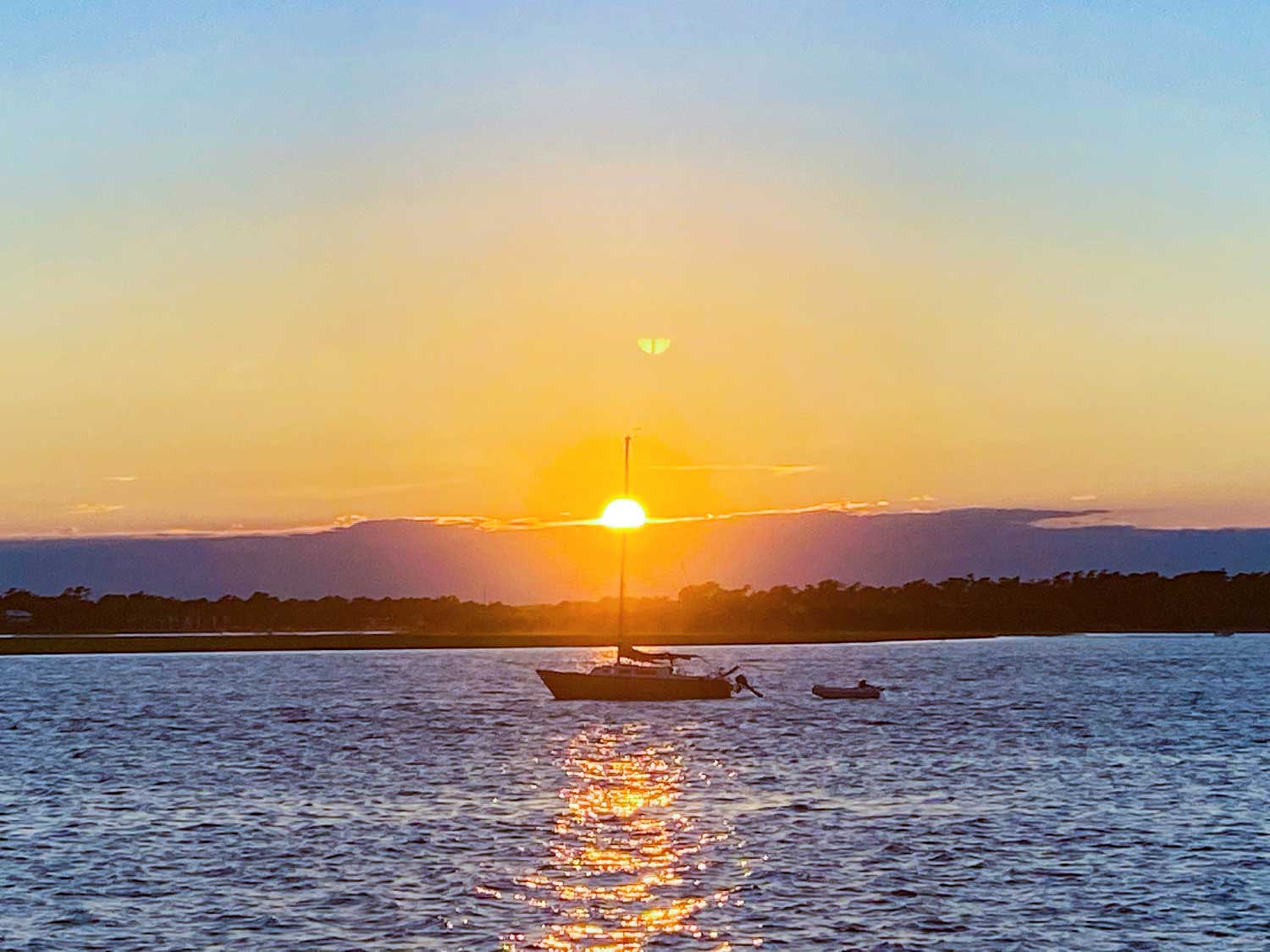
Marina Costs
If you’ve been researching the cost of living on a boat, you know it is more economical to anchor than to dock in a marina slip. We love anchoring out, but it does come with a set of variables that dictate comfort and safety while you’re on the hook. Not to mention, it requires a lot more planning.
Marinas can be expensive, especially in popular cruising areas. Dockage is usually charged per foot, so the bigger the boat, the higher the costs associated with docking fees. However, you can find liveaboard boat marinas with slip fees that are paid monthly.
Many cruisers prefer to dock at a liveaboard marina during hurricane season and save anchoring for cruising season. This allows you to keep your cost per night at marinas down, and your overall costs balance out throughout the year.
READ NEXT: Check out our post on Liveaboard Marinas: Finding the Best One for You.
Anchoring Challenges
Dreaming of our cruising days, I had the idea we would anchor out and rarely pay for marinas.
In reality, that’s not what worked for us out of the gate. Being beginner sailors and newbies to cruising and boats in general – there was an enormous learning curve.
Learning to live this lifestyle is not always easy. And yes, marinas make it easier. Especially when you REALLY need it to be easier.
Anchoring out requires the captain to always be “on”. You must be aware of the weather, wind direction, currents, and tides. You also have to be aware of the boats around you. None of this stops when you leave the boat or when you sleep.
The reality is you need to slowly become more comfortable living on the hook.
With experience, you can build more confidence.
You’ll become more comfortable with boat systems, weather, and making repairs while on the anchor. Conserving power and water becomes more natural, and you learn how to stay warm in the cold and cool off in hot weather. With some practice, you can spend less time (and money) at marinas.
For folks dreaming of this lifestyle, I’m not saying you won’t be able to start living on the anchor immediately. But the stress level accompanying living on the hook will lower with time and experience.
Provisions
Average Cost $449
Provisions are consistently one of our most significant expenses on the boat.
Anticipating my new life on the water, I knew I wanted to learn more about cooking, baking, and making things from scratch. And since we planned to live on a smaller budget, I also wanted to be conscious of spending on food.
Groceries
A game I often play with myself is to see how long we can go until the next big provisioning trip.

You might be thinking – that sounds miserable. But we eat pretty darn well most of the time.
We ration veggies and fruits, ensuring we leave the hardiest for last. We start with fresh salads and other raw veggie meals, such as cilantro hummus bowls. As the freshest veggies thin out, we work our way to curries and stir-fries. Then, when the fridge grows empty, we move on to rice and bean dishes, pineapple and jalapeño pizza, and bean tacos with pickled onions and cabbage.
One skillset you develop living on a boat is the ability to eat more sustainably.
Learning to make bread, yogurt, and vegetable broth from scraps is super satisfying.
Spend time learning to make flexible meals. Use a balance of fresh, canned, and dried ingredients. Do this, and you can stretch your provisioning budget without sacrificing flavor.
You can also save money by minimizing disposables, such as paper towels, sandwich bags, plastic wrap, and aluminum foil.
READ NEXT: Check out our ideas for Flexible Meals on a Boat and our Best Zero Waste Swaps for Small Spaces.
Alcohol
Having sundowners is a bit of a staple in the boating community. It’s a common way to meet and greet other boaters in a marina or in an anchorage. Given that, we always like to have a few extra beers onboard or the ingredients for a simple cocktail.
We love good wine, but we managed to find some enjoyable boxed wines. (Bonus, lose the boxes at the dock, and there’s very little trash to contend with.)
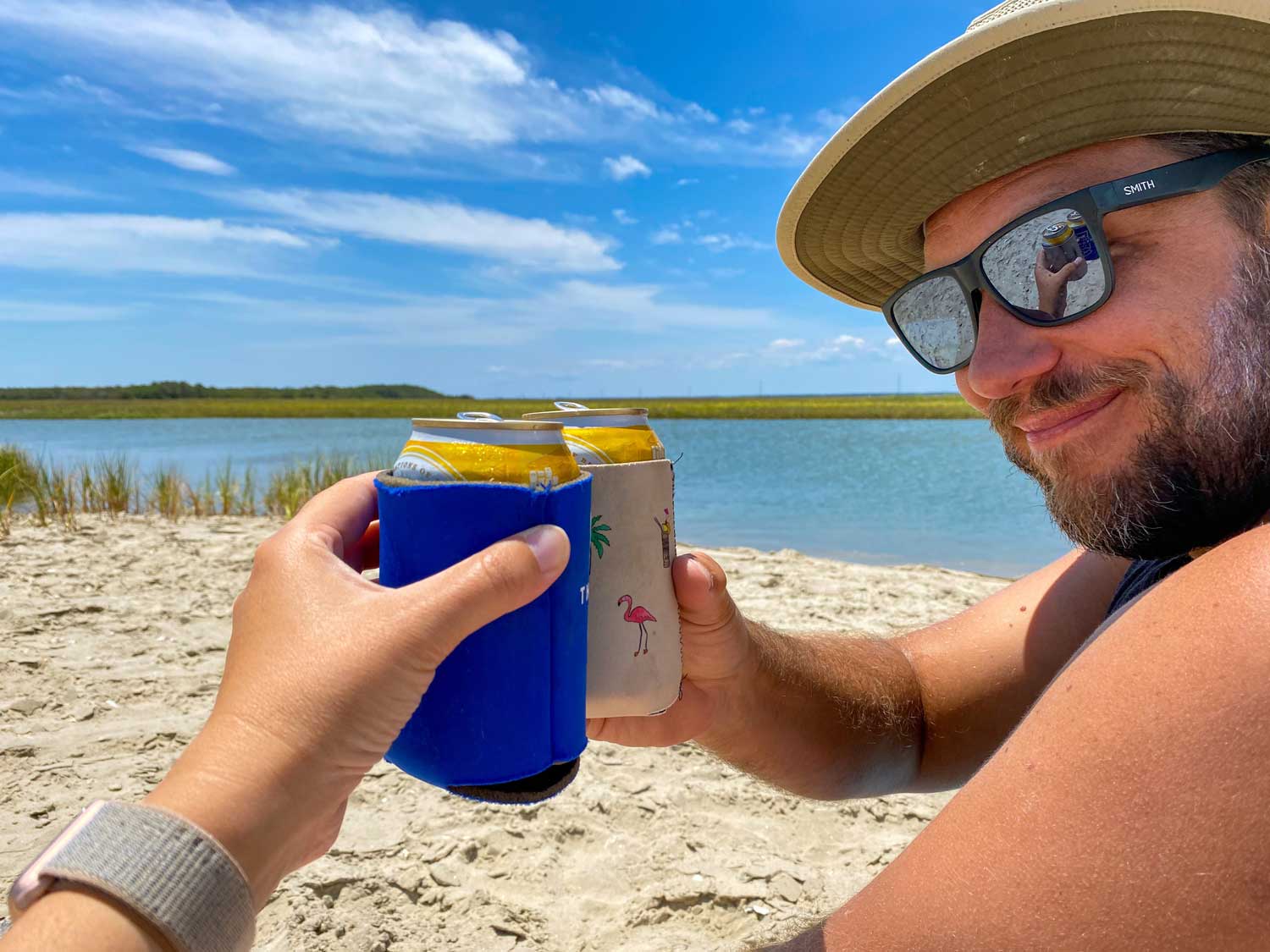
When we find a deal, we stock up on beer. Nothing hits the spot like a cold beer after the anchor drops. We even discovered a reasonably priced rum we enjoy. (No boat is complete without rum!)
Expenses here are based on personal taste. For us, it was possible to have more affordable beverages and still enjoy sundowner traditions!
Dining Out
Average Cost $233

As a couple who dined out regularly in our Colorado ski town, it was going to be tough to start cooking three meals a day living aboard.
I read a lot of advice that said, “if you like eating out, you probably won’t stop eating out because you move on a boat.”
There is truth to this. Whenever we are in a place where eating out is convenient, we tend to fall back into old habits.
However, when we dock in remote places or anchor away from shore access, there is less (or no) opportunity to eat out.
Instead, we experiment with different types of food to make meals onboard rewarding.
We still enjoy going out to experience the local cuisine, but it has become a treat instead of how we live.
A great way to cut costs is by dining out for a late lunch rather than dinner or skipping the alcohol. Opting for a refreshing drink on the trampoline while watching the sunset isn’t a bad way to close out a night.
Fuel
Average Cost $103
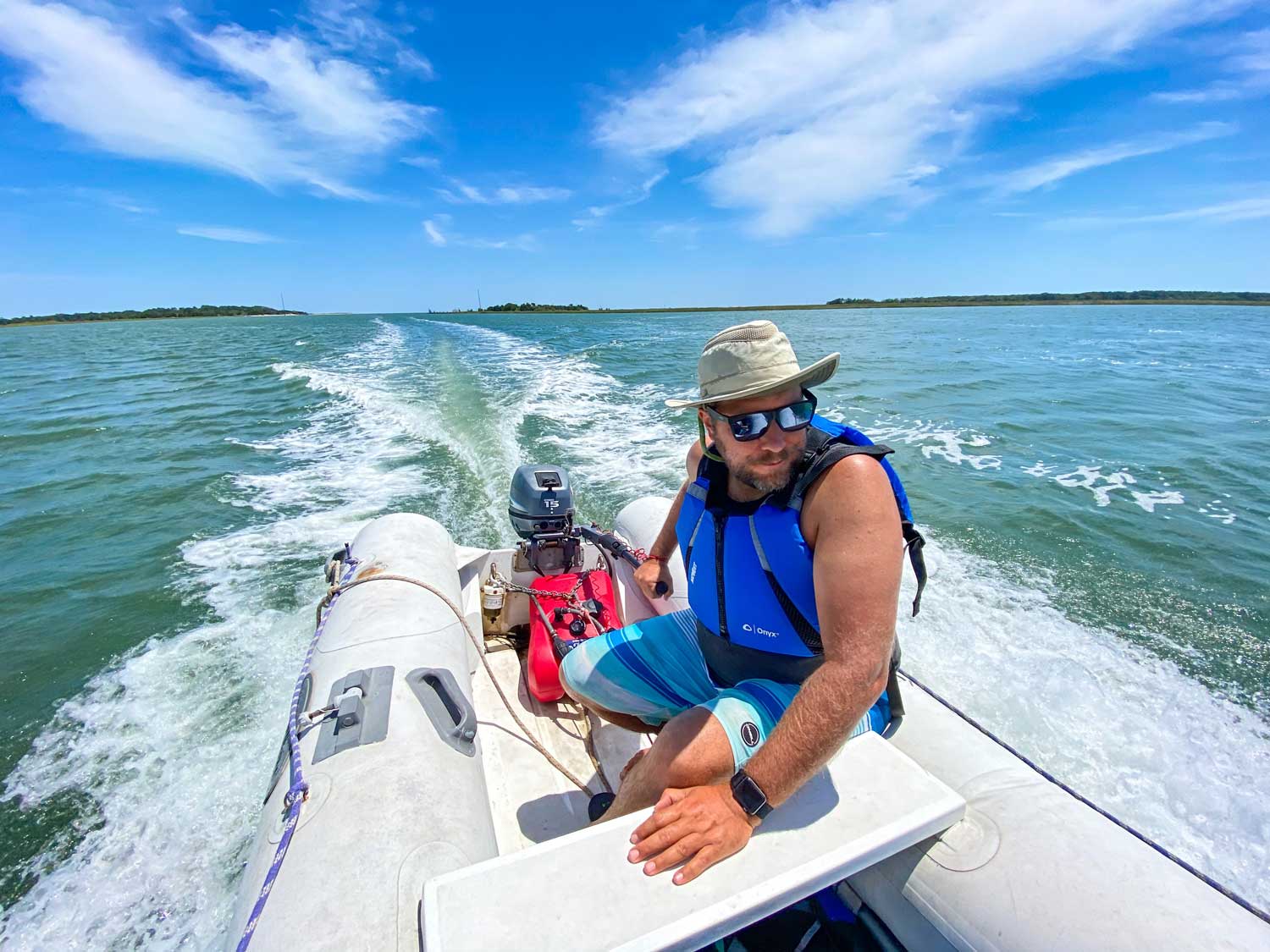
Diesel, gas, and propane are three resources you will continuously be aware of while living on a boat.
Here are a few adjustments we make to maximize our fuel efficiency.
Diesel
- We use our sails. This isn’t easy as new sailors on a big boat. We have slowly become more confident, but it took us months of traveling on the water to start getting comfortable using the sails. We are still learning.
- We don’t put ourselves in a position where we are in a hurry or have a schedule. This almost always leads to running the engines more.
- We run on one engine. We can run one engine instead of two on our catamaran and only lose about 1 – 1.5 knots. On the ICW, we unfurl the jib to improve speed if the wind is right.
- We always make sure to travel at an optimal time for the current. Some areas of the Intercoastal Waterway can have a current that’s pushing 2-3 knots. Choosing a departure time around the current makes a big difference in travel time and fuel efficiency.
Propane
- Heating water with the electric kettle if the engines are running or we are on shore power.
- Using hot water from the engines (when we have it) to get water boiling.
- When cooking pasta, we use a minimal amount of water. We’ll often turn the propane off and let the noodles finish cooking in the hot water.
- Quality cookware makes a big difference. Once brought to a boil, some dishes can finish cooking with the lid on. This is helpful when coming into an anchorage. Often, I’ll kill the propane, and by the time we are anchored, dinner is ready.
Gas
- If we plan to make a few trips to shore, we’ll anchor closer to the dinghy dock. This doesn’t always work out, but being conscious of it has helped us stretch our gas budget.
- If it’s a short trip to the dock and we aren’t carrying supplies, we use the kayak. Paddling is free (and fun)!
Internet
Average Cost $140
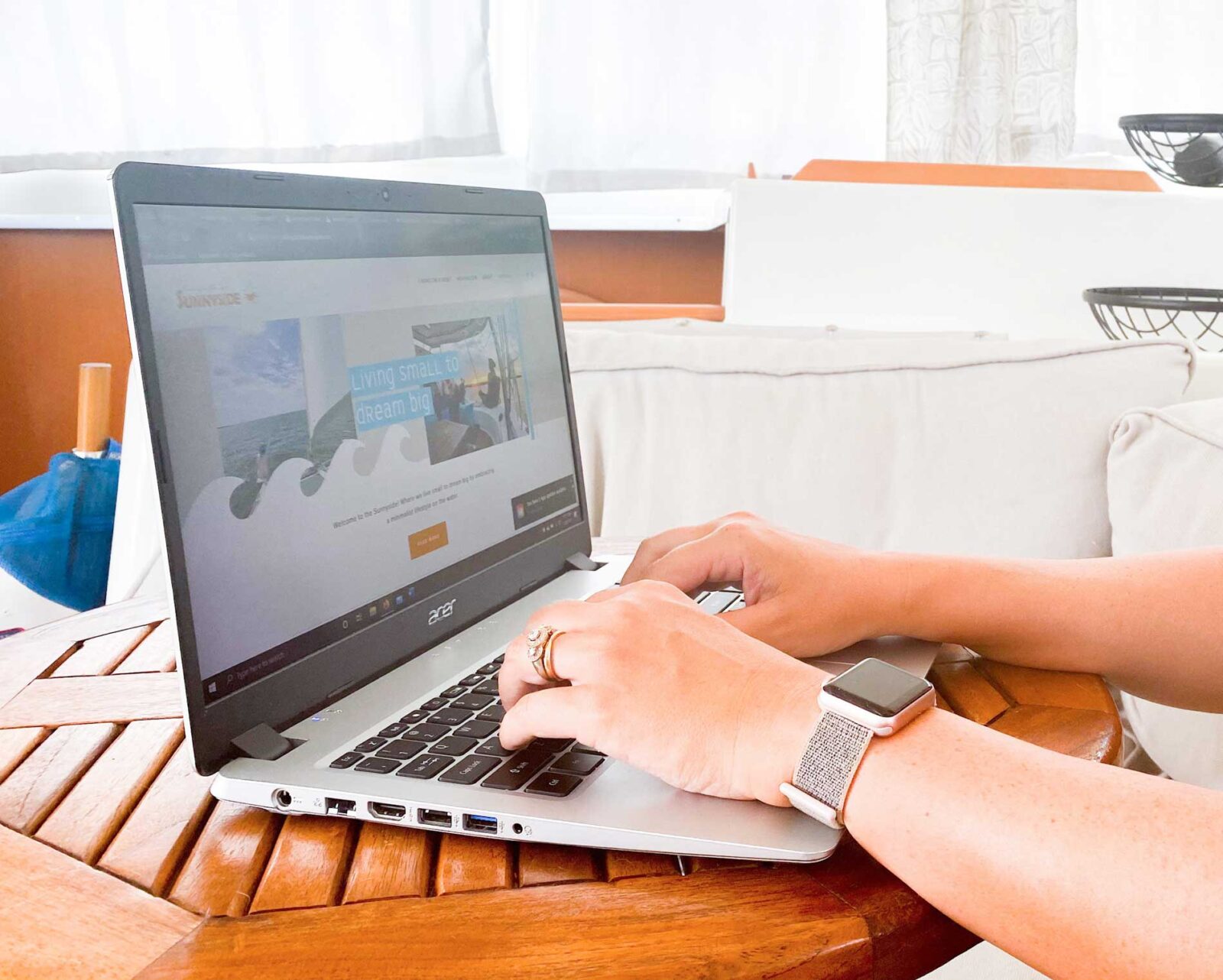
When we were saving for the cruising kitty, we found ways to cut our mobile bill by using data on our home and work WiFi. When we moved aboard, our phone plan became the primary internet source. We quickly realized we would need to rethink our data plan.
There are a lot of options for unlimited data in the US, as well as hotspot data. I recommend having at least unlimited mobile data for research and logistics involved when cruising. If you need to work from the boat, you may also want to invest in an additional mobile service as backup or satellite internet. Starlink is starting to become popular in the boating community.
Our Mobile Plan
While cruising the east coast, we use T-Mobile. With this carrier, we get unlimited data and 40GB of hotspot data each month (20GB per phone). This is on the pricier end, and we have been looking into other options, but we enjoy having the hotspot data. Even after the 40GB, we still have hotspot data at 2G. When we cruise the Bahamas, we are planning to use My Island WiFi service.
Entertainment
Average Cost $23
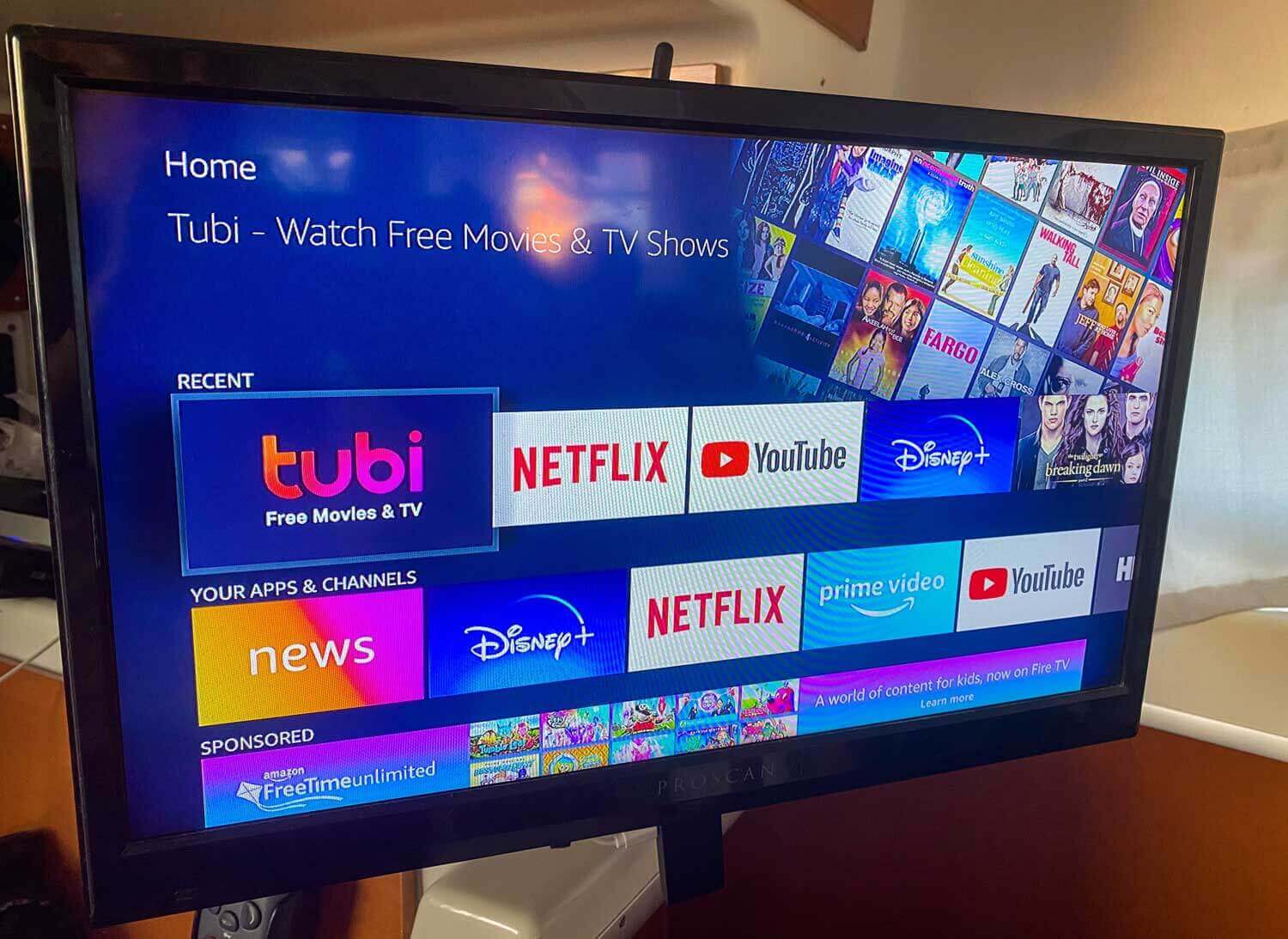
This category is for consumable entertainment since most other entertainment on the water is free.
Music, movies, and books are popular forms of entertainment onboard. Even when we cut down on spending, we kept a few options that provided these services. Instead of ditching all the monthly streaming apps, we looked hard at our memberships and cut back or found free services to supplement.
- Spotify membership for music (we can download or stream) $11
- Movie library on an external hard drive created before we ditched our DVDs Free
- Hulu (included with Spotify) Free
- Audible $8
- Disney Plus (prepaid for three years during a special offer) $4
- Nexflix (included with T-Mobile plan) Free
- Tubi (a free streaming app) Free
Spotify and Audible are great for downloading books and playlists for when you are out of service or on passage. You can also download movies and shows through many streaming apps for playback when you don’t have a signal or are running on a budgeted amount of mobile data. An external hard drive of your favorite movies is also a great source of video entertainment that will never let you down.
Personal Care & Clothing
Average Cost $73

Hair & Skin Care
Go more natural with skin and hair care. Most boats won’t have spare power for hairdryers and straighteners. On top of that, the sun and humidity will destroy makeup.
Start now researching ways to simplify your personal care regimens. It will make the transition abroad much easier.
Tips for Hair & Skin Care
- Get a tinted moisturizer with SPF for your face (I like Raw Elements), a flexible eye shadow, and waterproof mascara. Opt for reusable makeup remover cloths to cut down on waste.
- Work on a natural look for your hair, and see if you can find a style you can cut yourself. Shampoo and conditioner bars are a great way to save space and are typically made with clean ingredients that won’t harm sea life.
- Opt for a simple personal care routine. The fewer products you use, the more space, time, and money you’ll save.
- We love to use UPF clothing in combination with sunscreen. The more you can cover up, the less sunscreen you’ll need.
Health
For us, this area is where expenses remain similar to land life. There are no unique expenses with health or dental care, although finding healthcare coverage for multiple states can be challenging.
For the lady sailors, I recommend researching ways to have a zero-waste period. A menstrual cup is something I wish I had transitioned to before cruising. It will make your life easier, plus save you money and storage space.
Laundry
If you can minimize laundry and wash some stuff on board, you can limit the need to find a washing machine.
Tips for Laundry on a Boat
- Wear clothes that are easy to wash and dry and can be worn several times between washes.
- In the summer months, wear UPF synthetics and bathing suits that can be washed by hand. This will also extend their life.
- In the winter months, wear merino wool and dress in layers to get the most wears out of your clothes before washing.
- Save sheets, towels, and bulkier clothing for when you have access to a washing machine. We aim to do machine washing about once a month.
Having a solid system in place for handwashing clothes helps limit our laundry budget. We average $8 per month spent on machines.
Clothing
We try to buy high-quality clothing that is durable for boat life. Once you’ve created a boat wardrobe that works, you’ll find there is little you will need.
In six months, the only clothing I have purchased is a UPF shawl, a sun hat (to replace one I lost overboard), and a tank top. I previously spent a lot of money on clothes. Now I enjoy dialing in a functional, minimalist wardrobe for living on a boat.
READ NEXT: For more on clothing for boat life, check out What to Wear Sailing and How to Downsize Your Wardrobe.
Travel
Average Cost $58
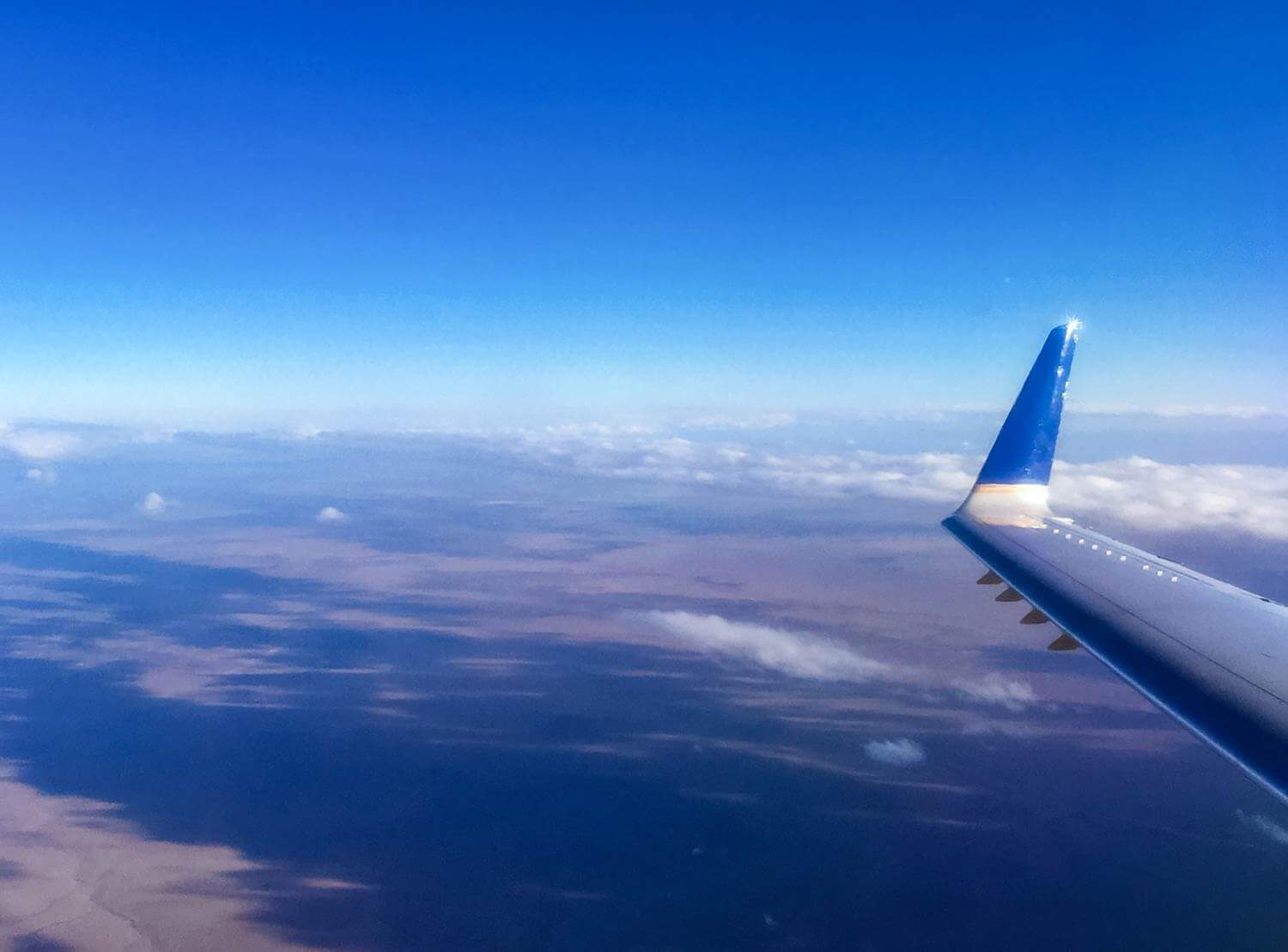
For us, our travel budget for many years has consisted of only credit card membership fees. These help us earn points that pay for our travel.
Booking a flight or rental car without worrying about how it affects the budget is a nice perk in this lifestyle. There are times you need a car to get a project done or to book a last-minute flight to visit family.
We also get an annual travel credit with the Chase Sapphire Reserve credit card. We use a lot of the credit toward Ubers and Lyfts – great for when grocery stores aren’t within walking distance or you need to make a larger provisioning run.
Getting Started With a Cruising Budget

Here are some final thoughts when creating your future sailboat cruising budget.
- The above expenses are based on actively cruising on our 38-foot catamaran. For us, extended time at the dock is just a redistribution of funds. Maintenance and fuel go down, and marina expenses go up.
- Our maintenance costs are at about 4% of the hull value. Aside from the trampoline, we have not replaced any big-ticket items, so we expect this percentage may increase over the next couple of years.
- If you hope to stretch your cruising kitty, give yourself time to overcome the learning curve. Learning to maintain, operate, cook, and just be on a boat will take time. As you get more experience, your spending habits will improve. Be patient and keep moving forward.
- I highly recommend you continue researching and reading as much as possible about the cost of living on a sailboat. Get perspectives from different cruisers. This will help you create a cruising budget that will be unique to you.
Other Resources
- Gone with the Wynns created a very detailed article and video that breakdowns their cost of living on a boat.
- Sailing Kittiwake also has a great video on the cost of living on a sailboat on a budget.
*Costs not included in this overview are health insurance, taxes, business expenses, and gifts or donations. These expenses are particular to each individual’s situation and so are excluded from this article.
Want more tips on how to get started cruising on a boat?
For more information on the reality of boat life and tips for living on the water, view our complete guide.
Like this post? Save it on Pinterest for later.
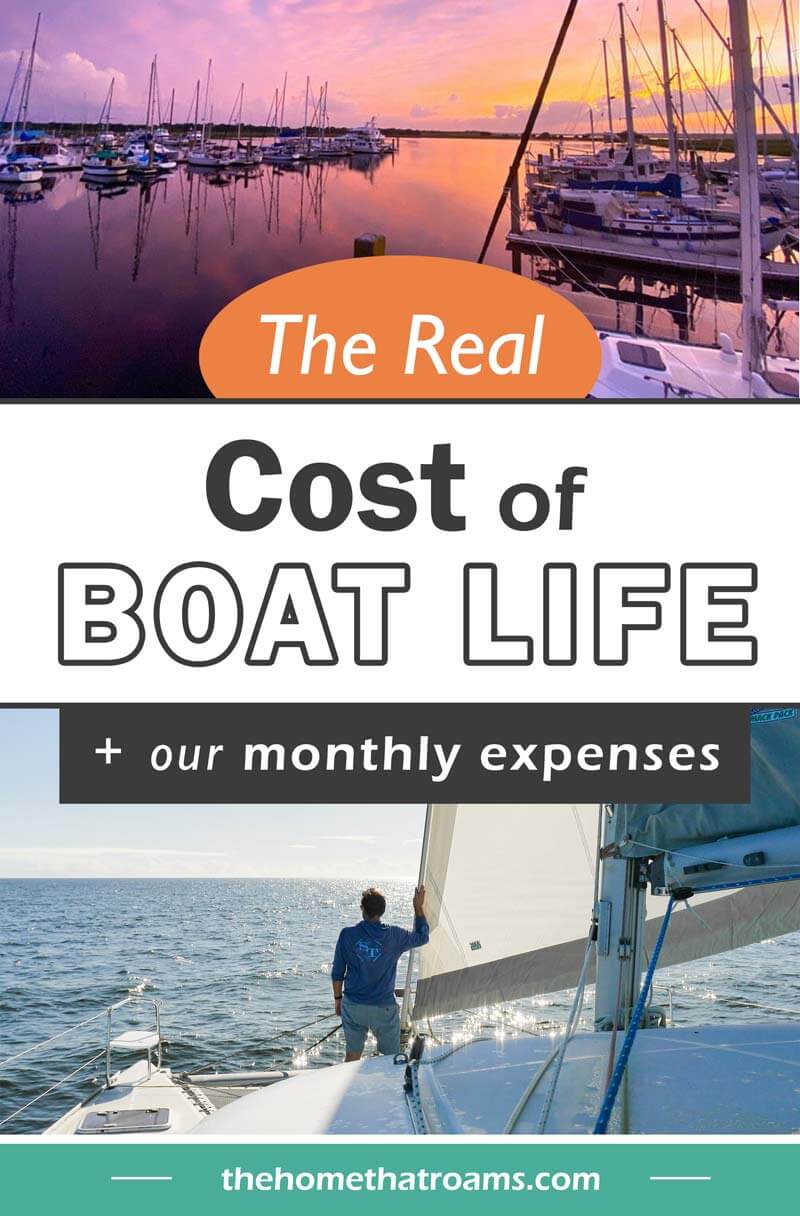
Or view our web stories.


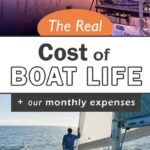
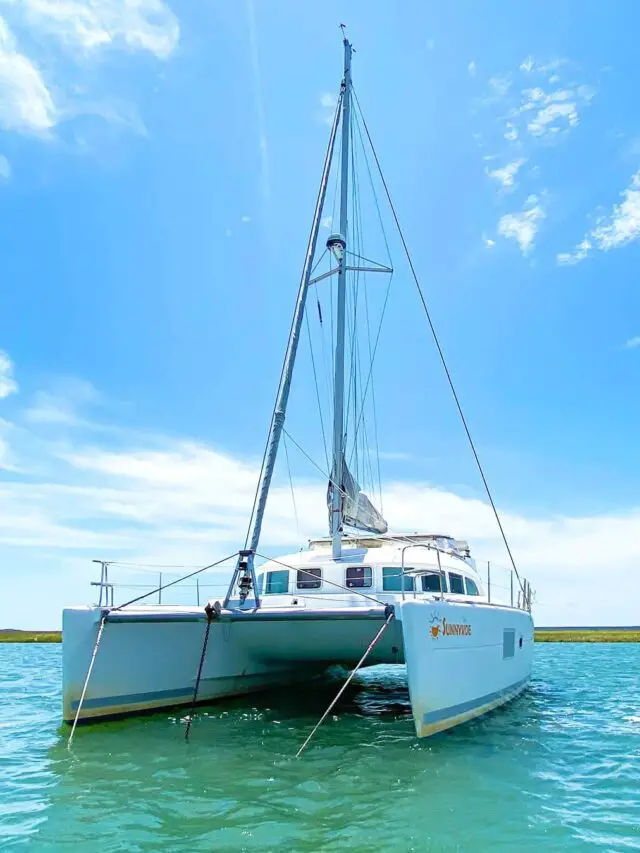

Excellent article. Thank you!
I started getting the urge to return to the sea not long after I got out of the Navy in 1974…. Started out on a 15′ Phantom…. Up to 21′ Keels, up to a 26′ Bristol and finally a 28′ Newport…. You learn alot of tricks of the trade at a working marina… Barter system, I used to go up the mast or anything Aloft in return for favors with anything that I had a problem with …. Had to give up the sailboat when I couldn’t sail it by myself anymore … Looking for a 35′-38′ trawler to live in the Tampa Bay area for the rest of my day…. From the Sea I came, back to sea I will return … Anchor’s Aweigh….
Hi George, it sounds like you have lived and breathed boats for a while! One of my favorite things about a good liveaboard marina is how everyone trades boat maintenance favors and helps each other out. I sure hope you find a good trawler to liveaboard in Tampa – sounds lovely!
Do you use a specific budgeting software or anything to track your transactions? Please share if so